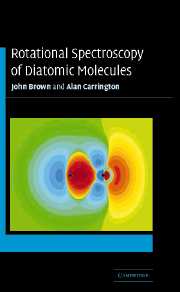Book contents
- Frontmatter
- Contents
- Preface
- Summary of notation
- Figure acknowledgements
- 1 General introduction
- 2 The separation of nuclear and electronic motion
- 3 The electronic Hamiltonian
- 4 Interactions arising from nuclear magnetic and electric moments
- 5 Angular momentum theory and spherical tensor algebra
- 6 Electronic and vibrational states
- 7 Derivation of the effective Hamiltonian
- 8 Molecular beam magnetic and electric resonance
- 9 Microwave and far-infrared magnetic resonance
- 10 Pure rotational spectroscopy
- 11 Double resonance spectroscopy
- General appendices
- Author index
- Subject index
- References
2 - The separation of nuclear and electronic motion
Published online by Cambridge University Press: 17 December 2010
- Frontmatter
- Contents
- Preface
- Summary of notation
- Figure acknowledgements
- 1 General introduction
- 2 The separation of nuclear and electronic motion
- 3 The electronic Hamiltonian
- 4 Interactions arising from nuclear magnetic and electric moments
- 5 Angular momentum theory and spherical tensor algebra
- 6 Electronic and vibrational states
- 7 Derivation of the effective Hamiltonian
- 8 Molecular beam magnetic and electric resonance
- 9 Microwave and far-infrared magnetic resonance
- 10 Pure rotational spectroscopy
- 11 Double resonance spectroscopy
- General appendices
- Author index
- Subject index
- References
Summary
Introduction
A molecule is an assembly of positively charged nuclei and negatively charged electrons that forms a stable entity through the electrostatic forces which hold it all together. Since all the particles which make up the molecule are moving relative to each other, a full mechanical description of the molecule is very complicated, even when treated classically. Fortunately, the overall motion of the molecule can be broken down into various types of motion, namely, translational, rotational, vibrational and electronic. To a good approximation, each of these motions can be considered on its own. The basis of this classification was established in a ground-breaking paper written by Born and Oppenheimer in 1927, just one year after the introduction of wave mechanics. The main objective of their paper was the separation of electronic and nuclear motions in a molecule. The physical basis of this separation is quite simple. Both electrons and nuclei experience similar forces in a molecular system, since they arise from a mutual electrostatic interaction. However, the mass of the electron, m, is about four orders-of-magnitude smaller than the mass of the nucleus M. Consequently, the electrons are accelerated at a much greater rate and move much more quickly than the nuclei. On a very short time scale (less than 10−16 s), the electrons will move but the nuclei will barely do so; as a first approximation, the nuclei can be regarded as being fixed in space.
- Type
- Chapter
- Information
- Rotational Spectroscopy of Diatomic Molecules , pp. 38 - 72Publisher: Cambridge University PressPrint publication year: 2003

